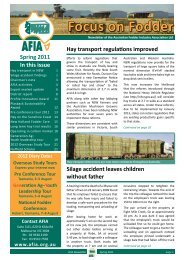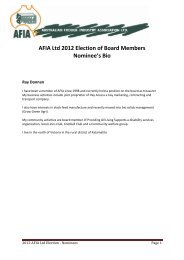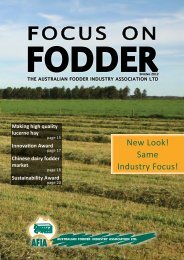AFIA - Laboratory Methods Manual - Australian Fodder Industry ...
AFIA - Laboratory Methods Manual - Australian Fodder Industry ...
AFIA - Laboratory Methods Manual - Australian Fodder Industry ...
Create successful ePaper yourself
Turn your PDF publications into a flip-book with our unique Google optimized e-Paper software.
Version 3<br />
Date 22/05/2011<br />
Method – 1.8R: Determination of Amylase Neutral Detergent Fibre by<br />
Refluxing<br />
National Forage Testing Association - Forage Analysis Procedure 5.1<br />
Scope: This method is applicable for the determination of amylase neutral detergent fibre (aNDF)<br />
in all types of forages and feeds.<br />
Principle: A neutral detergent solution is used to dissolve the easily digested pectins and plant cell<br />
contents (proteins, sugars and lipids), leaving a fibrous residue (aNDF) that is primarily cell wall<br />
components of plants (cellulose, hemicellulose and lignin). Detergent is used to solubilise the<br />
proteins and sodium sulphite also helps remove some nitrogenous matter; EDTA is used to chelate<br />
calcium and remove pectins at boiling temperatures; triethylene glycol helps to remove some nonfibrous<br />
matter from concentrate feeds; and heat-stable amylase is used to remove starch.<br />
Two additions of amylase (one during refluxing and one during filtration) have been observed to aid<br />
aNDF analyses and minimise filtering difficulties. Heat-stable amylases are used in hot solutions to<br />
inactivate potential contaminating enzymes that might degrade fibrous constituents.<br />
Equipment:<br />
Refluxing apparatus<br />
Berzelius beakers (600ml)<br />
Fritted glass (Gooch) crucibles (coarse porosity, 50ml)<br />
Analytical electronic balance, accurate to 0.1mg<br />
Suction filtering device with trap in line and valve to break vacuum<br />
Forced-air drying oven set at 100 o C<br />
Reagents:<br />
1. Neutral detergent solution - To make approximately 18 litres requires:<br />
• 17.82L Distilled water<br />
• 540g Sodium lauryl sulphate, USP<br />
Caution: wear dust mask and gloves when using sodium lauryl sulphate.<br />
• 335g Ethylenediaminetetraacetic acid (EDTA), disodium salt (may substitute 72g sodium<br />
hydroxide (NaOH) and 263g free acid EDTA as a less expensive alternative)<br />
• 122.6g Sodium borate, decahydrate (Na2B4O7.10H2O), reagent grade<br />
• 82.1g Sodium phosphate, dibasic (Na2HPO4), anhydrous, reagent grade and<br />
• 180 ml Triethylene glycol, reagent grade.<br />
<strong>AFIA</strong> <strong>Laboratory</strong> <strong>Methods</strong> <strong>Manual</strong> – v7 September 2011 Page 36 of 103







